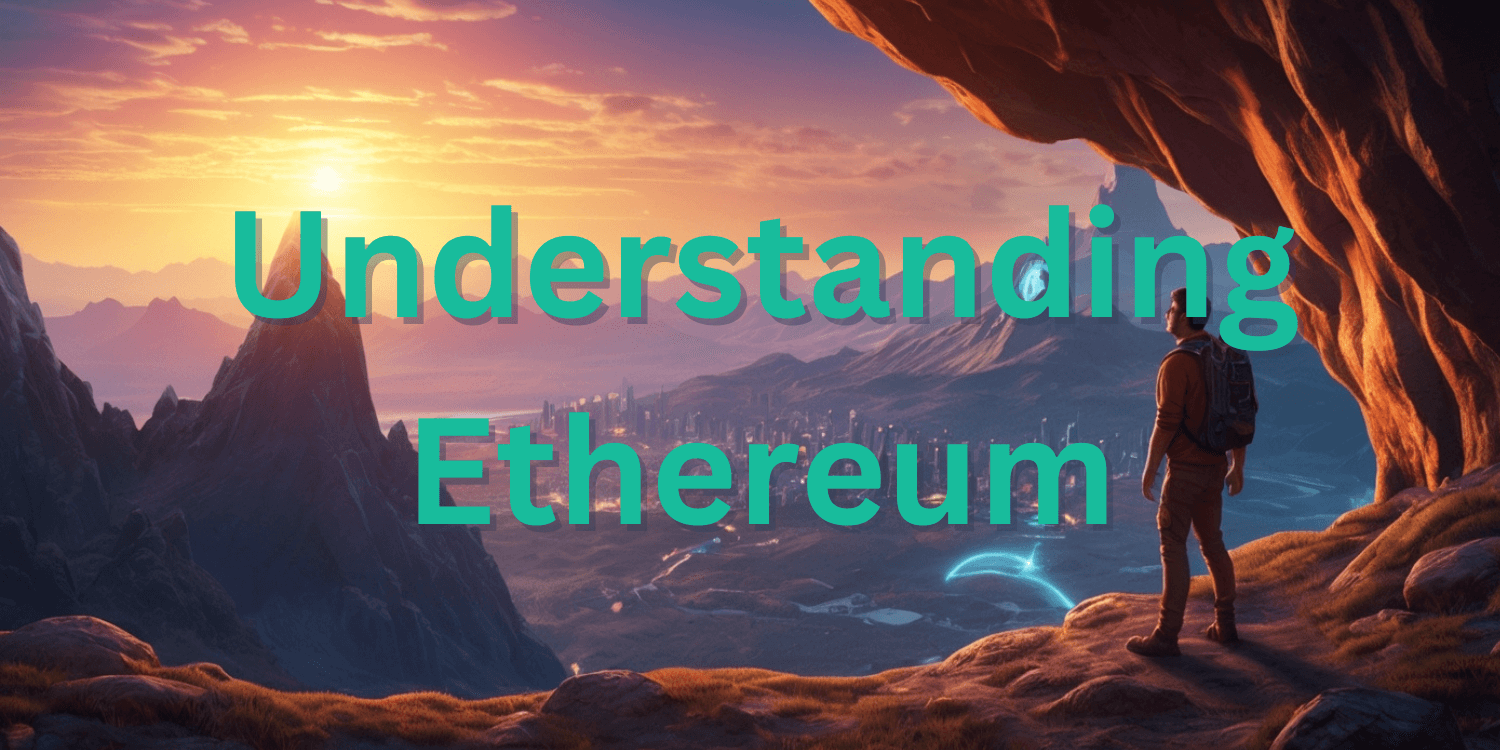
Understanding Ethereum: A Primer on the Whitepaper
May 19, 2024
Paul Simroth
Discover the goals and core concepts of Ethereum as outlined in its whitepaper, including smart contracts, decentralized applications (DApps), and the transformative potential of blockchain technology.
- Web3 Basics
Introduction
Blockchain technology has been a revolutionary force in the digital world, and Ethereum is one of the most significant contributors to this revolution. Launched in 2015, Ethereum is an open-source, decentralized platform that enables the creation and execution of smart contracts and decentralized applications (DApps). Unlike Bitcoin, which primarily focuses on peer-to-peer digital currency transactions, Ethereum provides a more versatile framework for various applications beyond financial transactions. This article aims to demystify the Ethereum whitepaper for those unfamiliar with blockchain and web3 technologies, explaining its goals, core concepts, and the potential impact on various industries.
What is Ethereum?
Ethereum, conceptualized by Vitalik Buterin, is a decentralized platform that allows developers to build and deploy smart contracts and DApps. Smart contracts are self-executing contracts with the terms directly written into code. They automatically enforce and execute agreements without the need for intermediaries, thus reducing the risk of fraud and lowering transaction costs.
The Ethereum whitepaper outlines the primary goals and technical foundations of the platform. It provides a comprehensive overview of how Ethereum operates, its underlying technology, and its potential applications.

Core Concepts of Ethereum
Blockchain and Decentralization
At its core, Ethereum operates on a blockchain, a distributed ledger that records all transactions across a network of computers. This decentralized approach ensures that no single entity has control over the entire network, promoting transparency and security. Each participant in the network has a copy of the blockchain, making it virtually tamper-proof.
Ether (ETH)
Ether (ETH) is the native cryptocurrency of the Ethereum network. It serves as a fuel for executing smart contracts and dApps, incentivizing participants to contribute computing power and secure the network. Users pay ETH as a transaction fee, known as "gas," to run applications on the Ethereum platform. ETH can be divided into smaller units, making transactions more flexible and accessible. The smallest unit is called a "wei," with one ETH being equivalent to 1,000,000,000,000,000,000 wei (10^18 wei). Other notable subdivisions include "kwei" (1,000 wei), "mwei" (1,000,000 wei), "gwei" (1,000,000,000 wei), and "szabo" (1,000,000,000,000 wei). These smaller units allow for precise calculations and facilitate microtransactions, enhancing the overall functionality of the Ethereum network.
Smart Contracts
Smart contracts are one of the most innovative features of Ethereum. These are autonomous programs that execute specific actions when predefined conditions are met. For example, a smart contract could automatically transfer ownership of a digital asset once payment is received. This automation eliminates the need for intermediaries, reducing costs and increasing efficiency.
Ethereum Virtual Machine (EVM)
The Ethereum Virtual Machine (EVM) is the runtime environment for executing smart contracts. It is a decentralized computer that runs on the Ethereum network, ensuring that smart contracts are executed consistently and securely across all nodes. The EVM is Turing-complete, meaning it can perform any computation given enough resources, providing a flexible platform for developers.
Goals of Ethereum
The Ethereum whitepaper outlines several key goals that the platform aims to achieve:
1. Decentralization: By eliminating the need for central authorities, Ethereum promotes a more democratic and secure internet. Decentralization reduces the risk of censorship and fraud, as no single entity controls the network.
2. Transparency and Trust: All transactions and smart contracts on the Ethereum blockchain are publicly verifiable, fostering trust among participants. This transparency is particularly valuable in sectors like finance, supply chain management, and governance.
3. Programmability: Ethereum allows developers to create complex applications through smart contracts. This programmability enables a wide range of use cases, from decentralized finance (DeFi) to non-fungible tokens (NFTs) and beyond.
4. Interoperability: Ethereum aims to support the seamless integration of various DApps, creating an interconnected ecosystem. This interoperability enhances the functionality and utility of the platform, encouraging innovation.
5. Security: The decentralized nature of Ethereum, combined with cryptographic principles, ensures a high level of security. The network is resistant to hacking and fraud, protecting users' assets and data.

Potential Applications of Ethereum
Ethereum's versatility has led to numerous applications across different industries:
Decentralized Finance (DeFi)
DeFi refers to a broad range of financial services that operate on blockchain technology, eliminating intermediaries like banks. Ethereum's smart contracts enable the creation of decentralized exchanges, lending platforms, and stablecoins. These applications provide financial services to unbanked populations and reduce costs for users.
Supply Chain Management
Ethereum can enhance supply chain transparency by tracking products from origin to destination on the blockchain. Smart contracts can automate processes like payments and inventory management, reducing delays and errors.
Digital Identity
Blockchain technology can provide secure, verifiable digital identities. Ethereum-based identity solutions can protect user privacy and prevent identity theft by giving individuals control over their personal information.
Governance
Decentralized Autonomous Organizations (DAOs) are a novel form of governance enabled by Ethereum. DAOs use smart contracts to implement rules and decision-making processes, allowing for transparent and democratic management of organizations.
Non-Fungible Tokens (NFTs)
NFTs are unique digital assets that represent ownership of a specific item or piece of content. Ethereum's smart contracts can verify and transfer ownership of NFTs, enabling new business models in art, gaming, and entertainment.
Technical Challenges and Solutions
The Ethereum whitepaper also addresses several technical challenges and proposes solutions to ensure the platform's scalability, security, and sustainability.
Scalability
As the Ethereum network grows, it faces scalability issues, meaning it can struggle to handle a large number of transactions simultaneously. The whitepaper suggests various solutions, such as sharding, which involves splitting the network into smaller, manageable pieces called shards. Each shard processes transactions independently, increasing the overall capacity of the network.
Security
Security is paramount in a decentralized network. Ethereum employs cryptographic techniques to secure transactions and smart contracts. The whitepaper also discusses the importance of rigorous testing and formal verification to ensure the reliability of smart contracts.
Energy Efficiency
Ethereum's old consensus mechanism, Proof of Work (PoW), required significant computational power, leading to high energy consumption. To address this, Ethereum transitioned to Proof of Stake (PoS) with Ethereum 2.0. PoS reduces energy consumption by requiring validators to hold and "stake" ETH as collateral rather than solving complex mathematical problems in order to mine a block.
Conclusion
The Ethereum whitepaper lays the foundation for a transformative platform that extends beyond digital currency. By enabling the creation and execution of smart contracts and dApps, Ethereum aims to democratize access to various services, promote transparency, and foster innovation across industries. Despite challenges such as scalability and energy efficiency, ongoing developments and proposed solutions highlight the platform's potential to revolutionize the digital landscape.
For those new to blockchain and web3 technologies, understanding Ethereum's core concepts and goals is crucial to appreciating its impact and future potential. As Ethereum continues to evolve, it promises to play a pivotal role in shaping the decentralized web and creating a more open, secure, and inclusive digital world.
